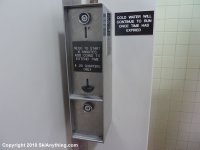Qapla
Veteran Member
Our house came with a 40 gal water heater. We have 3 bathrooms and four daughters. two of the baths are on one end of the home and the Master is on the other end with the kitchen in between but on the other side of the house (baths are near back while kitchen is near front).
We had an existing 40 gal water heater from our old house (it was only about a year old) so I installed that in the master area. Well, it did some odd things. Seems when the baths on the other end of the house were used it pulled the hot water from the master tank and when we used the master shower, it pulled the water from the other tank. I tried backflow preventers on the outflow but it did not help.
In the end, I had to disconnect the hot at the master tank coming from the other tank and use the master tank for ONLY the master and let the other one handle the rest of the house. It works great!
We have to replace the element in our tanks on a somewhat regular basis due to lime/calcium buildup. After some time we also had to start replacing the controls on the tank that came with the house so our oldest daughter decided to buy a new tank. She went with the largest that would fit the space. It is 80 gallons. Believe it or not, our electric bill went down.
We had an existing 40 gal water heater from our old house (it was only about a year old) so I installed that in the master area. Well, it did some odd things. Seems when the baths on the other end of the house were used it pulled the hot water from the master tank and when we used the master shower, it pulled the water from the other tank. I tried backflow preventers on the outflow but it did not help.
In the end, I had to disconnect the hot at the master tank coming from the other tank and use the master tank for ONLY the master and let the other one handle the rest of the house. It works great!
We have to replace the element in our tanks on a somewhat regular basis due to lime/calcium buildup. After some time we also had to start replacing the controls on the tank that came with the house so our oldest daughter decided to buy a new tank. She went with the largest that would fit the space. It is 80 gallons. Believe it or not, our electric bill went down.
